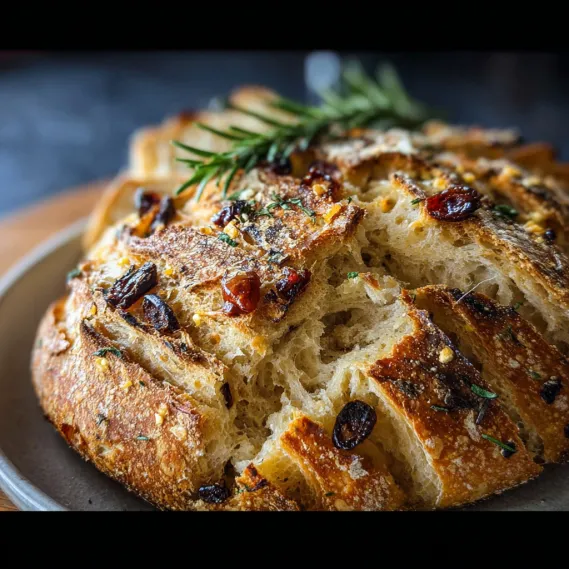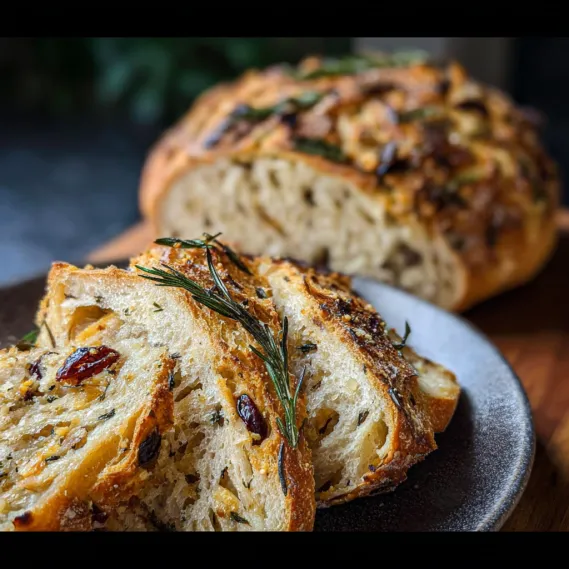 Pin
Pin
Rosemary Olive Sourdough Bread is the ultimate crusty comfort loaf that fills your kitchen with savory aromas. This bread gets its deep flavor from fresh rosemary, roasted garlic, and briny kalamata olives folded right into a simple overnight sourdough dough. With no kneading required and an easy rise overnight, it is a recipe you can start the night before for bakery-quality results right at home. The magic here is letting time and good ingredients do the work for you.
I first discovered this technique during a winter baking spree when I wanted something rustic and impressive but low effort. The herby olive scent practically had my neighbors knocking at the door to beg for a slice.
Ingredients
- Organic white bread flour: It gives structure and chew Ideally pick a high protein bread flour for the best rise and airy interior
- Sea salt: Enhances flavor and helps control fermentation Fine sea salt dissolves faster in dough
- Active sourdough starter: The soul of sourdough For best results use it after it has just peaked and is bubbly
- Water: Acts as the base for hydration Use room temperature filtered water if possible
- Kalamata olives: Provide big savory notes and pockets of moisture Use pitted and chop them for even distribution
- Fresh rosemary: Adds a piney aroma and herbal lift Pick fresh sprigs with firm green needles for the brightest flavor
- Roasted whole garlic cloves: Lend mellow sweetness Slow roast garlic for soft caramelized bites throughout
- Rice flour: For dusting the banneton or bowl Prevents sticking allows easy release of the shaped loaf
Step-by-Step Instructions
- Mix the Dough:
- Combine flour and salt in a large bowl In a separate bowl whisk sourdough starter with water until cloudy Pour mixture over dry ingredients Stir with a fork briefly then switch to a wooden spoon or dough whisk and mix for one minute Scrape down the bowl and incorporate every bit of flour The dough should feel heavy and shaggy Add a touch more water only if dry bits remain Uncover let rest fifteen minutes then perform two sets of stretch and folds fifteen minutes apart Lift up a section of the dough stretch up and fold it back over itself Rotate and repeat to create gentle structure
- First Rise:
- Cover the bowl with a damp kitchen towel Let sit on your counter overnight ten to fourteen hours at cool room temperature around sixty five to seventy degrees Fahrenheit By morning the dough should look puffed up but not quite doubled in size Use the poke test Lightly press dough with a floured finger The indentation should slowly spring back
- Prepare the Banneton or Bowl:
- Generously dust a banneton or medium mixing bowl lined with a towel with rice flour Scatter a few olives and rosemary sprigs into the bottom if desired This will leave decorative dots on the loaf
- Shape and Fill:
- Turn the risen dough out onto a well floured counter With lightly wetted hands flatten into a rough rectangle about one and a half inches thick Sprinkle olives chopped rosemary and roasted garlic evenly across the surface Using the dough scraper fold one long side over towards the center then the other to create a tri fold Turn the dough and rest ten minutes Gently flatten then fold again Pinch any seams closed and lift gently into the floured banneton seam side up
- Chill and Preheat:
- Place dough in fridge uncovered for one hour This helps build oven spring and makes scoring easier Meanwhile place your covered Dutch oven in the oven and preheat to five hundred degrees Fahrenheit or four hundred seventy five degrees if your oven runs hot
- Score and Bake:
- Lay parchment paper over the banneton and invert dough onto it Brush off excess flour Use a lame or very sharp knife to score the top about three quarters of an inch deep at a shallow angle Remove the preheated Dutch oven add the dough on parchment replace lid fast and return to oven
- Bake to Perfection:
- Bake covered for twenty minutes with convection or twenty five without Then remove the lid and finish baking ten to fifteen minutes until the loaf is a deep golden brown and crackling on top Internal temperature should reach two hundred four to two hundred eight degrees for best texture
- Cool Before Slicing:
- Remove from the Dutch oven and let bread cool one hour on a rack or propped on its side to avoid sogginess This step is tough but prevents a gummy crumb and ensures the crust stays crisp
 Pin
Pin
I have made this bread for countless potlucks The fresh rosemary from my backyard always gets compliments and the roasted garlic makes each bite extra memorable My kids now call this the Sunday loaf because it has become a beloved end of the week tradition
Storage Tips
Keep the cooled loaf wrapped loosely in a clean kitchen towel to preserve crispness for one to two days Leftovers freeze well Just let cool completely slice and store in a freezer bag Defrost at room temperature or toast straight from frozen for a quick snack
Ingredient Substitutions
No kalamata olives Use any briny olive you love even green or Castelvetrano If you are out of fresh rosemary swap in thyme or oregano Try roasted shallots or sun dried tomatoes in place of garlic for a new flavor spin
 Pin
Pin
Serving Suggestions
Serve thick slices alongside soups or stews for soaking up broth It makes show stopping bruschetta when toasted and rubbed with raw garlic For an easy meal sandwich soft scrambled eggs bacon and cheese between two pieces and grill until melt in your mouth
Bread’s Mediterranean Roots
Sourdough has a rich tradition around the world People have been combining wild yeast with flour and salt since ancient times The olives and rosemary call to the sun dappled bread traditions of southern France and Italy Every loaf bakes up a story older than any recipe
Recipe FAQs
- → Can I substitute other olives for Kalamata?
Yes, try green or Castelvetrano olives for a different flavor. Drain and chop before adding for best results.
- → Do I need a banneton for proofing?
No, you can use a parchment-lined bowl dusted with flour as an alternative to a traditional banneton.
- → Why does the dough need an overnight rise?
The long rest allows natural fermentation, resulting in better flavor, open crumb, and an airy texture.
- → How do I know if my sourdough is fully baked?
The interior should reach 204–208°F, and the crust will be deep golden and crisp. Tap for a hollow sound.
- → Can I add whole wheat or rye flour?
Yes, substitute up to 1/2 cup for a more robust taste, but avoid adding too much to keep the loaf light.
- → What's the best way to serve this bread?
Enjoy it fresh with olive oil, soup, or cheese. Toasted slices pair beautifully with savory spreads.
